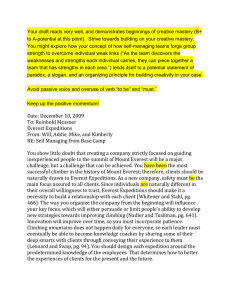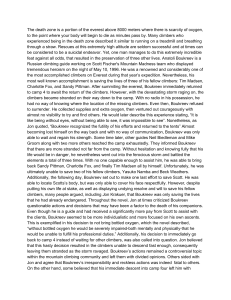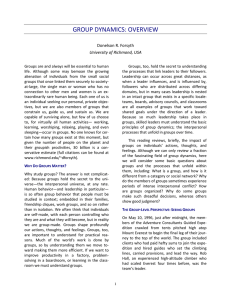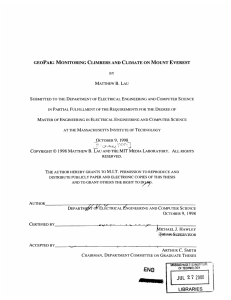Basecamp-final - Basecamp-Addie-Kimberly-MichaelM-Will
advertisement
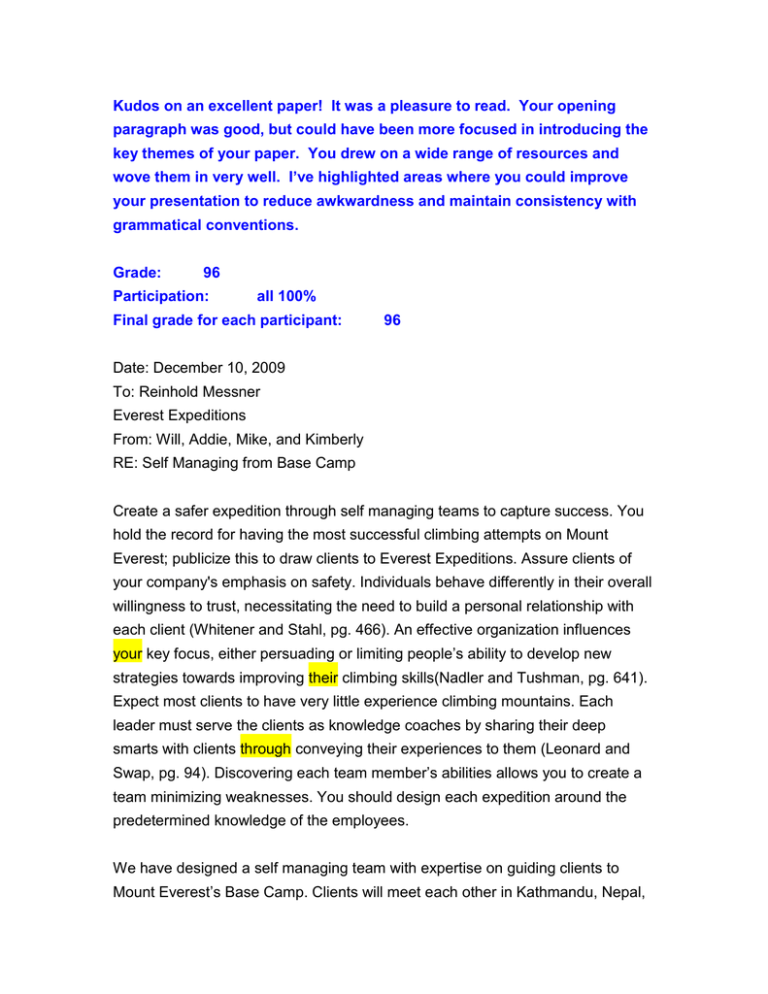
Kudos on an excellent paper! It was a pleasure to read. Your opening paragraph was good, but could have been more focused in introducing the key themes of your paper. You drew on a wide range of resources and wove them in very well. I’ve highlighted areas where you could improve your presentation to reduce awkwardness and maintain consistency with grammatical conventions. Grade: 96 Participation: all 100% Final grade for each participant: 96 Date: December 10, 2009 To: Reinhold Messner Everest Expeditions From: Will, Addie, Mike, and Kimberly RE: Self Managing from Base Camp Create a safer expedition through self managing teams to capture success. You hold the record for having the most successful climbing attempts on Mount Everest; publicize this to draw clients to Everest Expeditions. Assure clients of your company's emphasis on safety. Individuals behave differently in their overall willingness to trust, necessitating the need to build a personal relationship with each client (Whitener and Stahl, pg. 466). An effective organization influences your key focus, either persuading or limiting people’s ability to develop new strategies towards improving their climbing skills(Nadler and Tushman, pg. 641). Expect most clients to have very little experience climbing mountains. Each leader must serve the clients as knowledge coaches by sharing their deep smarts with clients through conveying their experiences to them (Leonard and Swap, pg. 94). Discovering each team member’s abilities allows you to create a team minimizing weaknesses. You should design each expedition around the predetermined knowledge of the employees. We have designed a self managing team with expertise on guiding clients to Mount Everest’s Base Camp. Clients will meet each other in Kathmandu, Nepal, because of the city’s location relative to the mountain and easy accessibility. All climbers should acquaint themselves well with each other because the journey will not be easy. This provides a sense of understanding of group dynamics and a sense of each other’s personalities. Assign leadership roles and allow clients to find their place within the group for the next two months. Team management provided by Everest Expeditions requires Level Five leadership, since achieving a successful journey hinges on climbers’ working to ensure the success of others before focusing on themselves. (Collins, pg. 477). Once everyone meets in Kathmandu, provide a helicopter to transport climbers to Lukla, Nepal before beginning the endeavor to the Base Camp. As they begin the hike along the path to Base Camp take note of the capabilities of each hiker, both physically and mentally. Once stronger and weaker clients emerge, it will help distinguish who you can rely on to help push the group forward and improve group dynamics, which provide important skills when reaching the summit (Gibson, pg. 324). When arriving at Base Camp, contact the respective camps farther up the mountain to determine what supplies and demands they may desire for making the hike less strenuous and more enjoyable for the hikers. Upon contact, it will be essential to not only listen to the demands of other camps, but to state what we expect or need in return. Having a clear, organized time line of required supplies will allow time for all materials to become available at the appropriate time. To properly treat and care for hikers requires communication between the camps (Lawler, pg.581). Listening to each participant provides an open environment where everyone articulates their interests. This in turn achieves the best possible solution in the steps needed from camp to camp and eventually the summit (Bourgeois, Eisenhart and Kahwajy, pg. 406). To effectively self-manage your teams, establish relationships and effective communication within the group. Additionally, organize a well thought and processed plan of action for the trip. Clearly define functions for each jobeveryone requires a role in providing responsible monitoring and managing their own performance (Druskat and Wheeler, pg. 340). Provide additional help in the form of constructive criticism and feedback to each team. As the climbers ascend Mount Everest, breathing becomes strenuous and labored, reducing the flow of oxygen to the brain and resulting in a lack of clear thinking capability. At this point, climbers incentives for being on the mountain should lead them to the summit (Bashorun and Miller, Slide 4). By reporting back to Base Camp on a regular basis to provide updated conditions, Base Camp can supply feedback and guidance. Seeking information from broader sources gathers more information together to help the team make educated decisions (Druskat and Wheeler, pg. 343). When a team learns to effectively self-manage, they begin to build a strong, “self-directed” group, an essential characteristic when climbing in the extreme conditions of Mount Everest. Base Camp encourages the process of self-management through training and team building. Base Camp further provides help to the other camps and the teams during travel through relationship building, organizational and administrative work, and through the facilitating of communication. by facilitating communication The beginning process of building a team consists of screening clients, selecting individuals capable of compatibility with one another, and each individual possessing the ability for the long journey. Climbers must demonstrate leadership skills, team work, and effective communication skills. These selected clients continue on to the next level of building relationships with each other and physical training for the hike. Provide clear instructions and continually reiterate safety procedures, guidelines, and rules within the group. The team should form a self-managed team that will effectively stay together as a group in an emergency situation. As the team discovers the weaknesses and strengths each individual carries, they can piece together a team that has strengths in each area. People who lack the ability to make a useful contribution in an incident management team do not belong on this type of expedition (Roberts, pg. 28). To summarize, place emphasis on emphasize team building and preparation before each expedition, and during each expedition maintain open lines of communication and a clear chain of command centered on Level 5 leaders. Accomplishing these goals requires a written plan of action for maximum effectiveness (Slavin, p. 88). Develop an act of consistency Act with consistency, to develop reliable results within expeditions (Anderson, Slide 3). Having the right leadership paired with carefully screened clients leads to successful climbs; and as your reputation for success grows, business increases. We recommend bringing together your leaders as soon as possible to clarify and carry out these goals. References: Anderson, Gideon. (2009). "Power and Influence." Retrieved from Class Presentation. Bashorun, A., & Miller, C. (2009). "Breaking the Code of Change." Retrieved from Class Presentation. Collins, J. (2001). “Level 5 Leadership.” Organizational Behavior Reader, pg. 477. Druskat, V. & Wheeler, J. (2004). “How To Lead a Self-Managing Team.” Organizational Behavior Reader, p. 340, 343. Eisenhart, K., & Kahwajy, J., Bourgeois, L., (1997). “How Management Teams Can Have a Good Fight.” Organizational Behavior Reader, pg. 406. Gibson, C. (2005). “Virtuality and Collaboration in Teams.” Organizational Behavior Reader, pg. 324. Lawler, E. (2003). “Why Treating People Right Pays Off.” Organizational Behavior Reader, pg.581. Leonard, D. & Swap, W. (2004). “Deep Smarts.” Organizational Behavior Reader, pg. 94. Nadler, D. & Tushman, M. (1999). “The Organization of the Future: Strategic Imperatives and Core Competencies for the 21st Century.” Organizational Behavior Reader, pg. 641. Slavin, A. (2009 October). Mastering Disaster. Best’s Review, p. 28. Retrieved from Business Source Complete database. Stahl, G., & Whitener, E.(2004). “Building Trust Within Global Organizations: The Theory.” Organizational Behavior Reader, p. 466. Roberts, P. (2007, October 23). Crisis management requires pragmatism. Computer Weekly, p. 28. Retrieved from Business Source Complete database.
